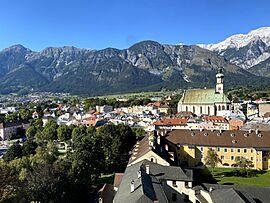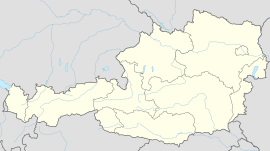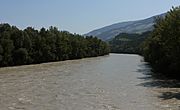Hall in Tirol facts for kids
Quick facts for kids
Hall in Tirol
|
||
|---|---|---|

The oldtown of Hall with Karwendel range
|
||
|
||

Location in the district
|
||
| Country | ||
| State | Tyrol | |
| District | Innsbruck Land | |
| Area | ||
| • Total | 5.54 km2 (2.14 sq mi) | |
| Elevation | 574 m (1,883 ft) | |
| Time zone | UTC+1 (CET) | |
| • Summer (DST) | UTC+2 (CEST) | |
| Postal code |
6060
|
|
| Area code | 05223 | |
| Vehicle registration | IL | |
| Website | www.hall-in-tirol.at | |
Hall in Tirol is a historic town in Austria. It is located in the Innsbruck-Land district of Tyrol. The town sits about 5 kilometers (3 miles) east of Innsbruck, the state's capital. It is nestled in the beautiful Inn valley. Hall in Tirol is 574 meters (1,883 feet) above sea level. As of December 2023, about 14,771 people live there.
Contents
A Glimpse into Hall's Past
Hall in Tirol has a long and interesting history. It was first mentioned in a document from 1232. Back then, it was known as a salina, which means a place where salt was produced. This was near Thaur castle. The name "Hall" comes from a Celtic word for salt. Other towns like Hallein and Hallstatt also share this salt-related name.
The Importance of Salt Mining
Since the 13th century, salt mining was the main industry for Hall and the areas around it. The salt mine was located at Absam, north of the town. In 1272, Count Meinhard II of Tyrol ordered the first mine tunnel to be built. Saltwater, called brine, was sent through a 10-kilometer (6-mile) pipeline. This pipeline carried the brine to a special pond in Hall where the water evaporated, leaving the salt behind.
The salt industry was very important. Hall exported salt to places like Switzerland, the Black Forest, and the Rhine valley. You can see how important salt was by looking at Hall's coat of arms. It shows two lions holding a barrel of salt.
Hall Becomes a Town and a Trading Hub
In 1303, Hall officially became a town. This gave it special rights that helped it grow. Trading goods along the Inn and Danube rivers made Hall a leading market and trading center in northern Tyrol. However, in 1447, a big fire destroyed much of the upper town.
The Famous Hall Mint
A very important event happened in 1477. The Tyrolian mint, which made coins, moved to Hall from Meran. In 1486, this mint created the first large silver coin in Europe, called the Guldengroschen. Later, in the 16th century, the Hall mint also introduced the world's first automated coining machine! Today, you can see a working model of this amazing machine at the Hall Mint Museum inside Burg Hasegg.
Hall's Golden Age
During the 15th and 16th centuries, Hall was one of the most important towns in the Habsburg Empire. Many beautiful churches, monasteries, and convents were built during this time. These buildings still make the town look special today. Hall has the largest old town area in western Austria that is still mostly intact.
Modern Times and Name Change
A military base was set up in Hall during the Habsburg monarchy. Because of this, and its large train station, Hall was heavily bombed during World War II. The train station was destroyed, but luckily, the old town remained almost untouched.
From 1938 to 1974, the town was called Solbad Hall. The word "Solbad" means "salt spa." This part of the name was removed a few years after the salt mine closed in 1967.
Hall in Tirol's Weather
Hall in Tirol has a climate where winters are very important. It's a long, cold period with clear days and not much humidity. Most of the precipitation, or rain and snow, comes as snow. This type of climate is known as a "Continental Subarctic Climate."
Gallery
Famous People from Hall in Tirol
Many talented people have come from Hall in Tirol. Here are a few:
- Blasius Ammon (1558–1590) was an Austrian composer and singer.
- Christoph Grienberger (1561–1636) was a Jesuit astronomer.
- Hippolytus Guarinonius (1571–1654) was a doctor and scholar who lived in the area.
- Otto Stolz (1842–1905) was an Austrian mathematician known for his work in mathematical analysis.
- Werner Pirchner (1940–2001) was an Austrian composer and jazz musician.
- Ingrid Felipe (born 1978) is an Austrian politician.
- Janine Flock (born 1989) is a pioneer in skeleton racing, a sport where you slide head-first down an ice track.
- David Gleirscher (born 1994) won an Olympic gold medal in luge at the 2018 Winter Olympics.
Sports Stars from Hall
Hall in Tirol has also produced many successful athletes, especially in winter sports:
- Klaus Dibiasi (born 1947) is a famous diver who won three Olympic gold medals.
- Andreas Felder (born 1962) and Ernst Vettori (born 1964) are former ski jumpers who won Olympic medals.
- Christoph Bieler (born 1977) is a former Nordic combined skier and an Olympic gold medalist.
- Andreas Linger (born 1981) and Wolfgang Linger (born 1982) are brothers who won Olympic gold medals in luge.
- Peter Penz (born 1984) and Georg Fischler (born 1985) are former lugers who won Olympic silver and bronze medals.
Sister Cities
Hall in Tirol has special connections with other towns around the world. These are called "sister cities" or "town twinnings":
 Iserlohn, Germany, since 1967
Iserlohn, Germany, since 1967 Winterthur, Switzerland
Winterthur, Switzerland Sommacampagna, Italy
Sommacampagna, Italy
See also
 In Spanish: Hall in Tirol para niños
In Spanish: Hall in Tirol para niños














